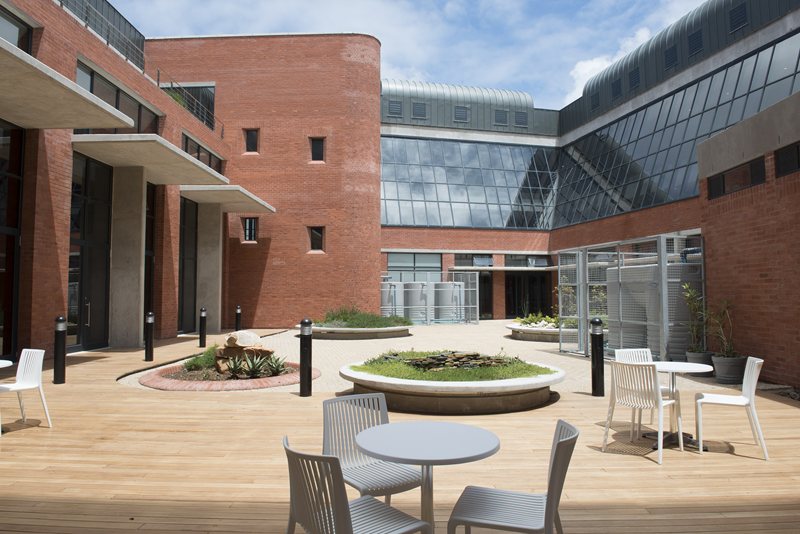TWO new state-of-the-art buildings set for completion this year will cap a decade of unprecedented infrastructure growth at Nelson Mandela Metropolitan University (NMMU).
A R57-m Life and Physical Sciences building on South Campus and a R56-m Foundation Phase building on Missionvale Campus form part of R1.1 billion spent by the Department of Higher Education and NMMU since in 2009 in support of its teaching, learning and research.
“The completion of these two buildings – both in support of national priorities for more science and teaching graduates – will mark a period of exceptional building growth at NMMU,” says NMMU Director: Infrastructure Projects and Sustainability Greg Ducie.
The new buildings, along with other major projects since 2009, all form part of the university’s award-winning urban design framework – a framework that offers a philosophical approach to university planning and design.
“We believe the latest infrastructure outlined in the urban design framework will set NMMU apart in terms of a space utilization perspective,” says NMMU Deputy Vice-Chancellor Dr Sibongile Muthwa, adding that many of its newest buildings would soon be officially opened as part of the university’s 10-year celebrations.
NMMU’s efforts in creating a university that focuses on pedestrians, puts nature first and carefully manages open spaces across several of its campuses has already received acclaim via its “beacon of hope” library in Missionvale, its iconic engineering building on North Campus and more recently when its “green” Business School was named the first in Africa to receive accreditation from the Green Building Council.
 In turn, the urban design framework which received the International Architectural Award in 2013 for its ability to “broadly organise a university but incorporate flexibility” is part of the university’s bigger strategic plan, Vision 2020. The latter is the brainchild of NMMU’s Vice-Chancellor Prof Derrick Swartz in guiding the university towards becoming “one of South Africa’s top universities”.
In turn, the urban design framework which received the International Architectural Award in 2013 for its ability to “broadly organise a university but incorporate flexibility” is part of the university’s bigger strategic plan, Vision 2020. The latter is the brainchild of NMMU’s Vice-Chancellor Prof Derrick Swartz in guiding the university towards becoming “one of South Africa’s top universities”.
The expansive infrastructure growth plan plays a key role towards Vision 2020.
At times during the past decade, NMMU has been the busiest building site in the metro.
In 2010, for example, after the first round of DHET funding was received, NMMU built a new library at Missionvale Campus, upgraded and expanded laboratories on the same campus, and introduced lifts and ramps for greater accessibility.
During the same funding period, NMMU built a new link road between its North and South campuses, built new lecture halls to the value of R45m, renovated its Architecture Department, converted its Embizweni building exam hall and upgraded ventilation and lighting in its main library and other buildings. A massive concrete rehabilitation also took place on its South Campus.
On the adjacent North Campus, several buildings were expanded and a 200-seat lecture hall was completed, while on the neighbouring Second Avenue Campus, the library was extended and the old gym was converted to the new home of the university’s archives.
On George Campus, one of NMMU’s six campuses, R26m was invested in a library, new lecture halls and computer labs. A new student recreational facility was established and a much-needed upgrade of infrastructure services was completed.
The next three-year cycle of funding saw NMMU build a R34-m High Resolution Transmission Electron Microscopy Centre - the most sophisticated building of its kind in the Southern hemisphere, housing a suite of powerful microscopes; renovate its pharmacy laboratories, build an iconic engineering block, a R116-m Business School, several new residences in the metro and on George Campus and complete new human movement science centre, complete with an indoor sprint track for research and a high performance centre.
The new Science block and Foundation Phase building for teachers are included in the latest three-year cycle of funding from both the Institutional Operating Plan and the Infrastructure and Efficiency Fund and are set for completion in December.
Both will meet a growing demand by students for qualifications in these particular career fields.
NMMU is now awaiting feedback on its latest application for funding (of R620m) from the DHET.
If successful, the bulk of the funding will go towards infrastructure to support proposed new maritime programmes in support of the country’s untapped blue economy and for much-needed on-campus residences. At present, NMMU houses about 12% of its 27 000 students on campus. It aims to increase this figure of 30% of the study body.
The last time the university enjoyed such exceptional infrastructure activity was when its predecessor, the University of Port Elizabeth, moved from its original Bird Street Campus to the present-day South Campus in the early to mid-1970s.